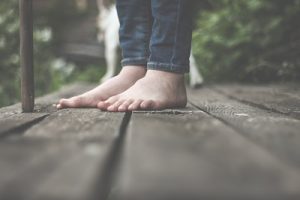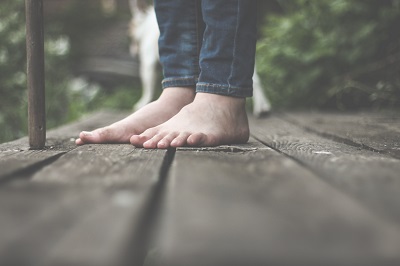Our feet are remarkable “objects”.
They are made up of twenty-six bones each, with thirty-three joints and a complex network of more than one hundred tendons, muscles, and ligaments, not to mention blood vessels and nerves.

Even large feet can appear small compared to the size of the body that stands on it when we consider that the rest of our body is supported on these relatively small platforms.
Standing on healthy feet
Healthy feet are supple and strong. The foot’s primary arch is raised but not rigid or frozen and there are several arches to one foot. Fibula and tibia, the lower leg bones, nestle atop a platform called the talus. Held in place by a collection of ligaments and tendons in a well-secured arrangement.

The toes actively participate in the working mechanics of a foot, they help to balance the weight as well as assisting in propelling the body forward and pivoting movements. Our ability to be supported on top of a relatively small surface is due to aligned bones in the feet, as well as throughout the body that balances the distribution of weight into the feet. Our feet and spinal alignment are in a close relationship with each other.
The foot’s arch is remarkable art
Did you know, that the foot’s arch has been reproduced in architecture throughout the centuries? The same design principle applies to bridges and feet equally.
Weight that is distributed evenly from above serves to increase the pressure of the two halves coming together, thus increasing their strength as well.

The importance of having a good foundation is just as important in the human body as in a building.
It is no wonder that evolution with every option available within natural physical laws chose arches to provide the best support possible for the weight of a relatively large and heavy body. In posture therapy the working or not working of feet clearly defines the whole skeletal structure; depending on how the weight is distributed on the feet and whether the inner arch of the foot is formed sufficiently.
The human body needs the feet to create “ground resistance” while standing and walking.
Ground resistance is one of the main principals of a well- balanced and functional posture. Translating the ground resisting force through the legs into the pelvis, thus stimulating the pelvic floor is the main function of the inner arches.
Daily routines on the go
Walking bare feet on the rough ground can bring back stimulation and some flexibility to these important foundations. Yoga and physical training can help us to stay light and yet solid on the ground. Sitting on the heels, kneeling and squatting are natural ways to keep feet flexible and hips open. The more flexible and relaxed our feet are the more they can support a functional body.

